Waiting for Resettlement – IDPs from Georgia and Azerbaijan
More than thirty years have passed since the armed conflicts swept the South Caucasus. Amid the dramatic breakup of the Soviet Union in 1991, dozens of ethno-political conflicts emerged in the former Soviet states. The nations living in the South Caucasus — once seen as coexisting with the “fraternity of peoples” concept — descended into war with one another, leading to more than 30 thousand deaths and the displacement of over 1.3 million people. Miserable stories of people affected by the wars in Nagorno-Karabakh, South Ossetia and Abkhazia wars are still being heard.
Some three decades since the armed conflict in Abkhazia, thousands of IDPs still live in unbearable conditions, waiting for real homes. The news about IDPs going on hunger strike and sewing their mouths in quest of homes, accusing the government of unfair distribution of apartments. On January 16, Zurab Kiria, an IDP from Abkhazia, died after jumping from a run-down IDP residence, seeking for the attention of the authorities. IDPs in Georgia have repeatedly gone on extreme measures to protest their unbearable living conditions in the buildings.
To date, 38,753 families in Georgia are awaiting for the housing. For the time being, they are forced to live in state-owned buildings — former hospitals, schools, sanatoriums, and hotels. Some live with relatives or rent a flat. According to the Public Defender’s Office, IDP families often live in buildings with increased danger to life and health. The Ombudsperson also said the procedures for relocation from such buildings remains problematic, and the statistics on these buildings need to be clarified to aid the state better understand the scale of the problem.
“They are waiting to our death, perhaps”
Tamar Akhvlediani, 87, has been waiting for her own home for years. Hailing from village Aradu of Ochamchire District, Tamar fled the war from Abkhazia with her family and settled in Tskaltubo, popular Soviet-era spa resort in Imereti region. Currently, she lives alone in Samurgali — one of the delapidated Soviet sanatoriums. Her son, a military serviceman, works in Tbilisi, while the daughter is married in Kutaisi.

Regretfully looking back at her life and years left in Abkhazia, Tamar recalls they had greatly different life there, out of which only memories remain. Describing the harsh reality she had to face during the post-war period, she says adapting to a non-familiar environment and forcibly leaving home in a day has not been easy for her like other IDPs.
“They are waiting to our death, probably. They told us they do not have one-room apartments and left us so till today. They are torturing us. We agree to settle down wherever they decide. Here it’s raining like outside,” — notes Tamar.
“I’d walk back if they let me. What a life I left there.”
Nana Liparteliani lived in Kelasuri, not far from Sokhumi. When the Georgian-Abkhaz war broke out she was just 17, about to finish school. Remembering trees, road, and rivers from childhood, Nana says her most beautiful years are connected with Sokhumi, Abkhazia’s prominent subtropical town.
“I remember everything… I often dreamed about my house, but in my dreams, I always entered from behind the house, not through the gate, and was seeing the light in the window as if someone was living. In reality, no one lives there, it has been turned into a forest,” Nana tells us.
Lately, Sokhumi and childhood are no longer in her dreams. She now also awaits for housing. Nana says his brother and sister-in-law, along with their 4 children, have already been given an apartment.
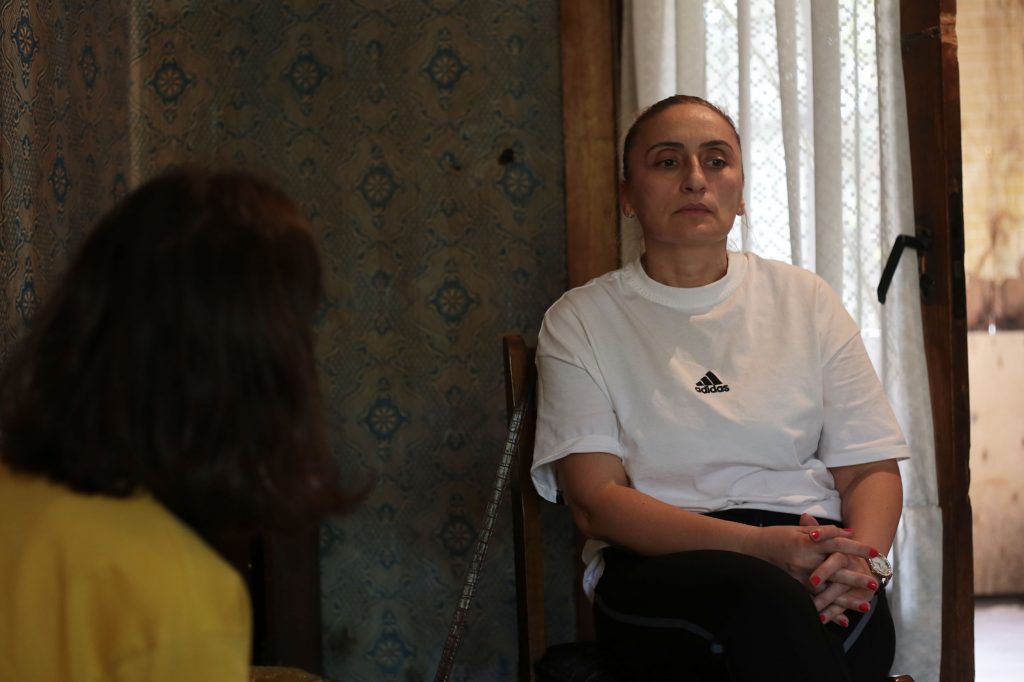
75-year-old Venera Kopaliani is from Sokhumi. Living in Samgurali with her 76-year-old husband turned out to be very difficult for her as well.
“Shared toilet, bathroom… Unbearable conditions for so many years. We were promised there will be resettlement. ‘Soon will be, soon will be’ — they were telling us, but we are forsaken with 40 families here. I am an oncological patient, in poor health,” Kopaliani says, adding: “Flats were given to those who were married, already had a house and they now sell the apartments. I am very disappointed.”
She also says that her family members have already been given the apartments.

What does IDP accommodation policy look like?
Since 2009, the Government of Georgia has been implementing a program to provide IDPs with long-term housing. The resettlement policy has been informal after 1993. Following the war in Abkhazia, IDPs arbitrarily settled down in the state-owned buildings. The process was accompanied by the government’s rhetoric that the return will be soon, if nor today then tomorrow, but to no avail.
Katie Sartania, a sociologist, says in 2004, the government introduced the so-called a large-scale privatization plan, which included the sale of state property to foreign investors. The privatization list also included hotels where IDPs lived, among them Hotel Iveria, current Radisson Blu Iveria in Tbilisi. Sartania says the state only acted as a mediator, not interfere in the negotiations between the IDPs and the private investor.
“Until 2010, IDPs were being evicted from various state-owned buildings. However, many IDPs opposed the process because in Tbilisi, in 2004, an investor offered them USD 7,000 for a room, something not sufficient to buy an apartment due to rising real estate prices at the time, and nobody took that into account,” says Sartania.
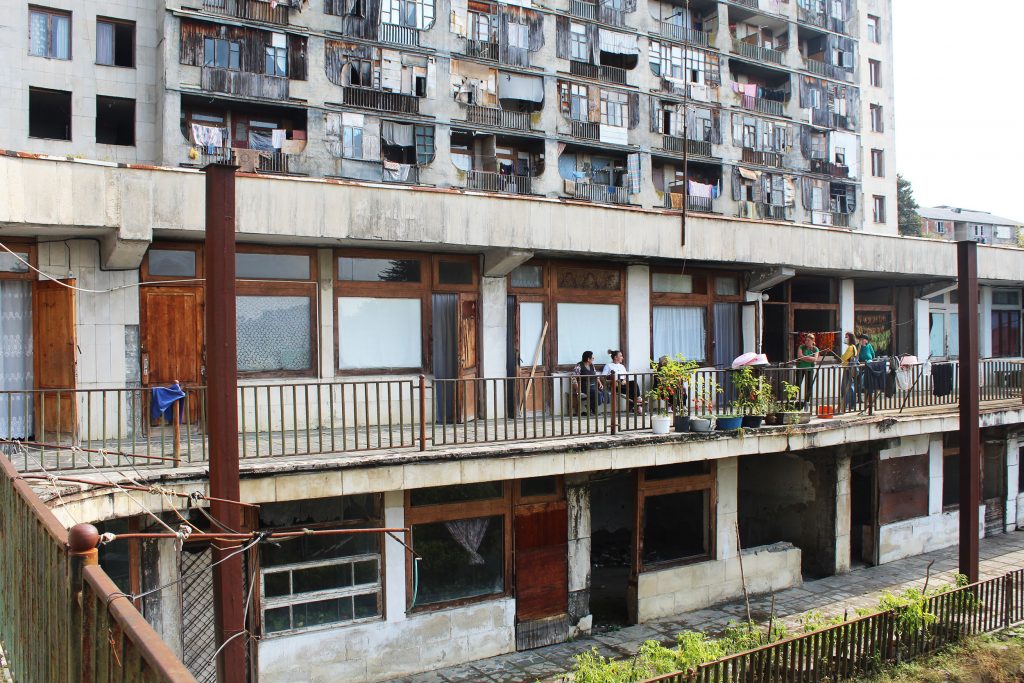
Sartania also says that some of the IDPs agreed to the offer, however, but many still could not get houses and moved again into state-owned buildings, with relatives, or started to rent places again. But, she continues, the Tbilisi City Hall would cut off water and electricity in these buildings to force IDPs to eventually vacate the places.
While the resettlement process was improved with the time, criteria was developed and the distribution of the flats is happening as per to social scores, experts argue that the process is not transparent and fair for many. For instance, housing is primarily offered to the families most in need, in an approach researchers see as encouraging poverty.
“The IDP resettlement strategy was renewed in 2008, meaning that before returning to Abkhazia or Tskhinvali region, the state had to provide them with decent living conditions, with cultural and social integration. But to find yourself in a resettlement program, you must live very poor conditions. Unemployment is also strong. There is a feeling of unfairness among the IDPs, that some of them got five apartments, others none of them,” Sartania asserts.
What is the government plan?
A total of 289,839 IDPs are registered in Georgia, including 262,431 from Abkhazia. The state has so far managed to provide only 44,060 families with housing or compensation. Speaking about the government’s four-year plan in August, the officials did not deny that many IDPs still live in poor conditions.
The Government also said they plan to provide housing for 13 thousand IDP families over the next four years. The plan stipulates that the government has to buy up to eight thousand apartments for IDPs, and up to five thousand will buy houses throughout the countryside. According to officials, the plan entails:
- Large-scale construction in the regions;
- Builders Project — apartments in newly built residential buildings for IDPs in Tbilisi and regions should be purchased;
- Rural house purchase project, according to which IDP family chooses the desired house in the countryside; and
- Legalization of living spaces.
According to the plan, 3,300 apartments should be built in Tbilisi by the end of 2024, 1,700 in Zugdidi and Kutaisi each, and 833 in Rustavi. According to Economy Minister Natia Turnava, more than 700 mln Lari (USD 230 mln) will be spent in total, which, at the same time, is a large state investment in the economy.
But why is the pace of housing provision slow? Researchers say the status of an internally displaced person itself is one of the reasons. The status of IDPs is inherited from parents to children, resulting in the number of IDPs growing and the government often fails to keep up with the provision. The IDP Agency’s data shows in 2020 alone, 3,933 persons received the IDPs status, of which approximately 90% (3,714 people) were minors.
Azerbaijani IDPs Too Are Waiting Their Living Conditions to Improve
“Because of the smell of moisture and sewage we cannot stand inside these rooms. We often have to go outside to get air,” 65-year-old Azerbaijani Beyim Garayeva says.
Garayeva became an IDP from the Aghdam region during the First Nagorno-Karabakh War. After getting married, she used to live in the Agdash, central Azerbaijan for some time. After the divorce, Garayeva and her daughter moved to an administrative building housing IDPs near Baku’s January 20 metro station.
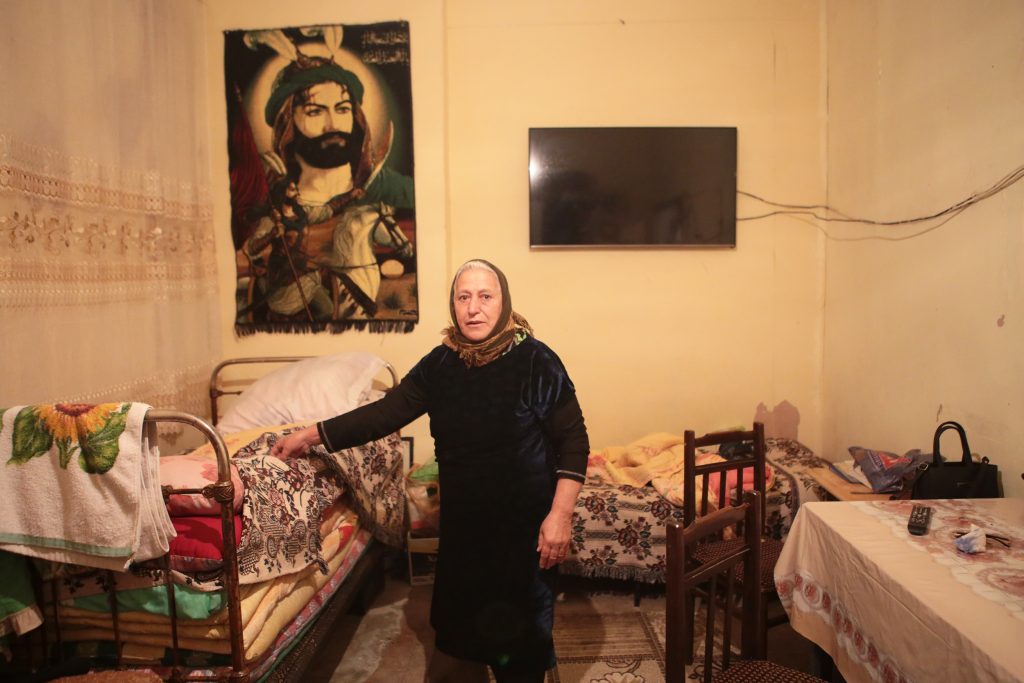
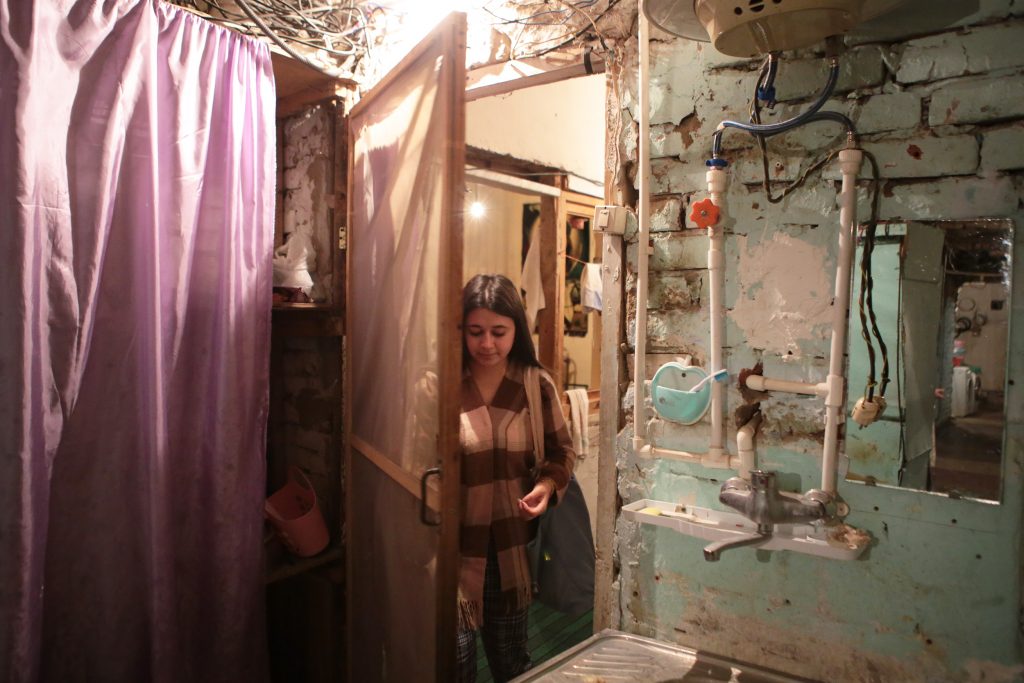
Beyim has been living with her daughter for eighteen years in a small, dimly lit room with no windows and a damp smell. She says the first floor was previously intended to be used as a garage, but the IDPs set up rooms there to stay. Beyim notes she has to repair the floor several times every year as water flowing from the basement keeps them eroding.
“About thirty-five families live on this floor and we are all on the sewer line. We have repeatedly appealed to the Refugee Committee, we were told that there is no house at the moment, preparations are still underway. But how can we live here during the pandemic?!” wonders Garayeva.
Ayten Yusifova, who lives next door to Garayeva, is originally from the Fizuli region. After being displaced in 1994, Ayten moved to Baku with her family — parents and sisters — and settled in one room here. Here she got married, now having two children. After the divorce, she started her own small confectionery business in a small, tiny room outside the building.
Ayten says since April 2021, the government has provided a house in the Fizuli region to two families living in the building, including his mother. Others are still waiting.
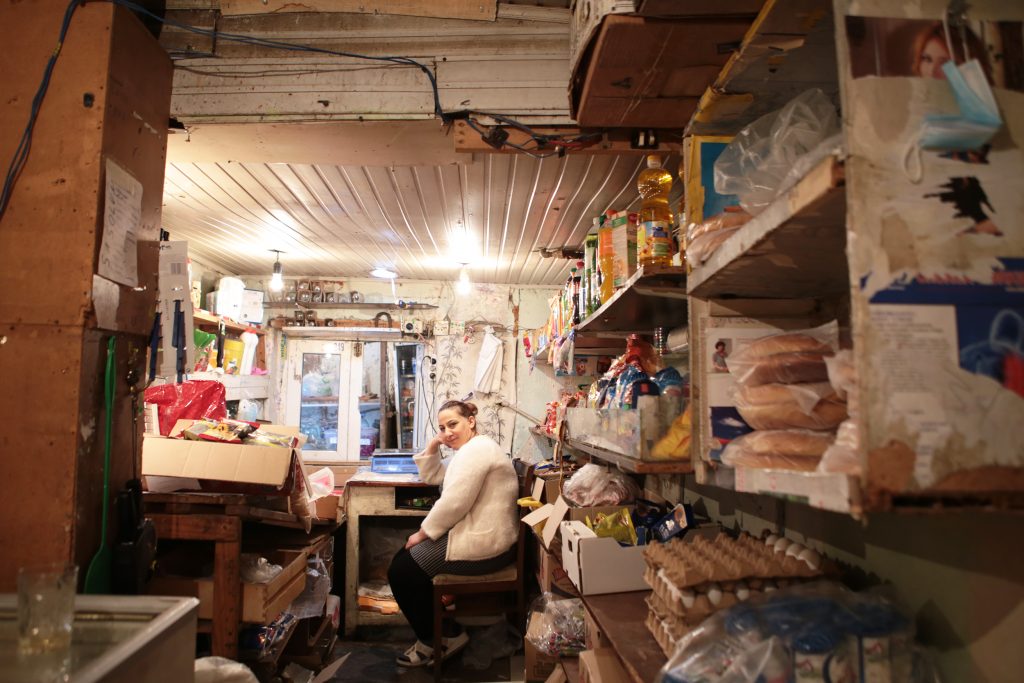
The Azerbaijani Government estimates that more than 1 million people were displaced from Karabakh and surrounding districts during the First Karabakh War in the early 1990s. At that time, IDPs were forced to temporarily settle in various regions of Azerbaijan, including the capital city of Baku, primarily in tent camps, underground excavations, railway carriages, basements, schools, kindergartens, dormitories and other administrative buildings. With the financial support of the government, 12 tent camps were abolished in 2003-2007 and the people were relocated to new settlements.
According to the State Committee for Refugees and Internally Displaced Persons, 116 new settlements have been built for IDPs in different cities and regions across the country, and more than 320,000 IDPs have been relocated to new settlements till this date. As per statistical data of the State Statistics Committee, in 2017-2020, the government provided 14,079 IDP families with housing throughout Azerbaijan, including 6,188 that settled in new buildings in Baku.
In September 2020, some two days before the war began, President Ilham Aliyev ordered the allocation of 42.5 mln manats (USD 24.7 mln) to the State Committee for Refugees and Internally Displaced Persons of the Republic of Azerbaijan from the presidential reserve fund, as envisaged in the 2020 state budget to improve the living conditions of IDP families. The Committee said in July 2020 that it was planned to provide 23,850 IDP families living in life-threatening conditions with new housing in Baku during 2020-2024.
Although the construction of a set of settlements and residential complexes to improve the housing conditions of IDPs was completed by the end of 2020, with the exception of 30 individual houses built in Fizuli, other new apartments were given to the families of martyrs and veterans of the Second Karabakh War by the decision of the President.
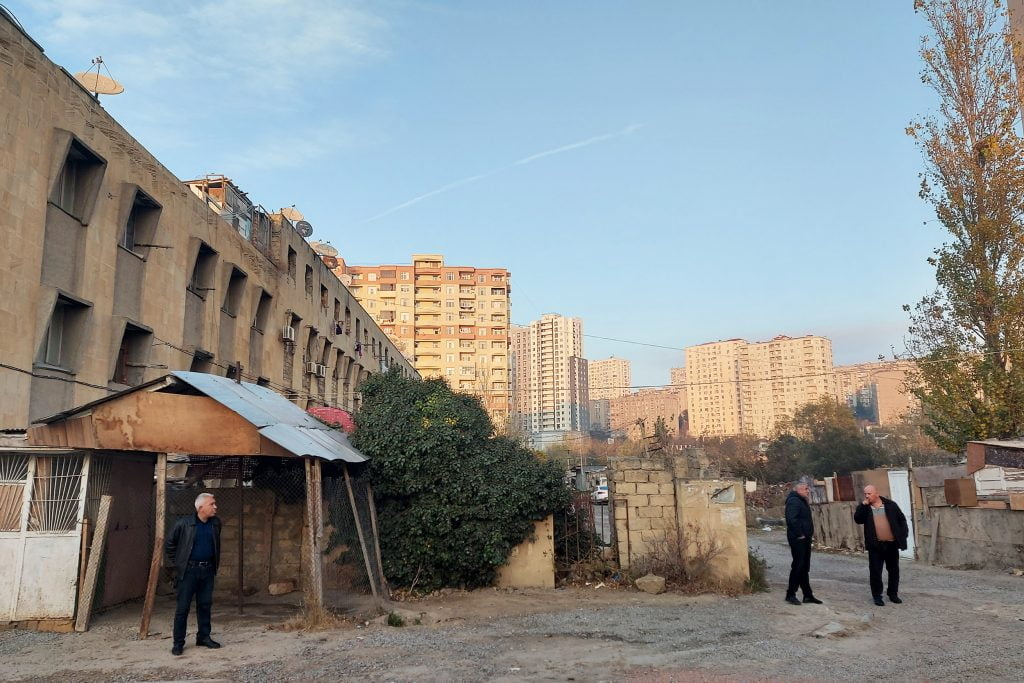
IDP families temporarily housed in an administrative building in the eye hospital in the Khatai district of Baku, an unfinished building, also complain about their living conditions. Stones ready to collapse at the entrance and power lines hanging from the walls have become a problem that could endanger both children and adults at any time.
On the other hand, the walls of the rooms became unusable as a result of sewage flowing from the sewer lines and rains. The floors of the huts here are rotten with moisture. According to residents, here rats, frogs and snakes could be seen in summer. Families who take refuge in narrow windowless rooms say the health of children born in such conditions is also damaged.
Originally an IDP from the Aghdam region, Vafa Alasgarova and her husband moved to the first floor of the building in 2007 after getting married. Before that, she lived in a kindergarten in the Sabirabad region. Vafa got a daughter ten years after the marriage, who acquired anaemia.
“No one living here has a window outside… There is only a small window in the corridors. Due to lack of air, children born here have anaemia and lung problems,” says Alasgarova, adding that families living in the basement face more difficulties than those in the upper floors.
“This child grew up in our arms, spending every day in front of the Refugee Committee. We appealed with many neighbors to be given a house for at least a while, to live normally and then move there when houses are built in Aghdam. There was no result, there is no one to look after our appeal,” notes Vafa.
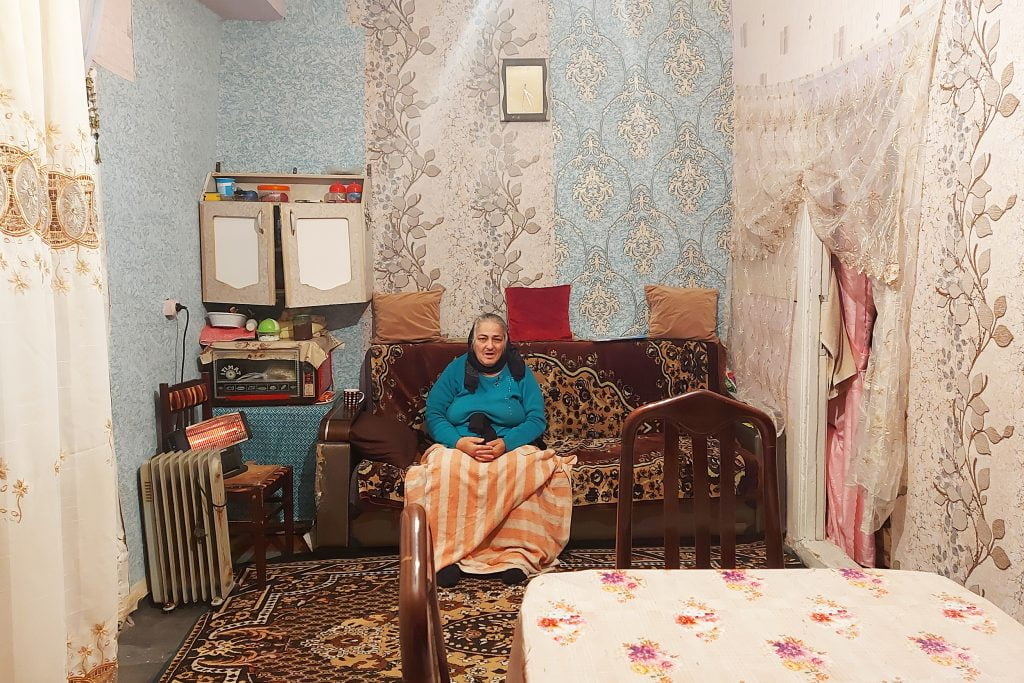
Gulbada Khalilova, 59, who lives in the Alasgarov neighborhood, also said she was in poor health. Khalilova, an IDP from Aghdam, says her health worsened since she arrived at the shelter.
“First I had gallbladder surgery, then I got kidney disease. My feet began to ache from the cold and humidity of the room. Gradually, I lost the ability to walk. In addition, I developed diabetes,” Khalilova says.
She tells us that now she has a tumor in her abdomen, and there is no financial means for the operation. The livelihood of a family of six is managed by the son, who works as a laborer, and the family’s per capita benefits.
Ganja City
“In 1993, we became IDPs from Kalbajar. When I came to Ganja, I was a child, I got married. Now I am 36 and I think I will get older here,” says Turan (not a real name), who lives in the dormitory building of the former Aluminum Factory in Ganja, Azerbaijan’s second largest city.
The building is in an emergency situation, but there is nobody interested in their situation, asserts Turan, who lives there with his wife and two children in a cramped two-room “apartment” with damp walls.
“The stones are old, the cement is rubbed and poured like sand. The rooms inside are very humid, cockroaches and insects are coming out of walls. It is unbearable to live here. The workers come, change the sewer pipes, but it has no use,” he complains.
Turan continues: “I was able to repair something in the room before. But it does not end with repairs, the building is not suitable for living anymore. I don’t have a permanent job to do anything now. Everyone living in the building is in this condition.”
About twenty other IDP families live in the building. Due to the lack of a basement in the dormitory, sewage from the sewers collects in the basement, and residents suffer from foul odors and unsanitary conditions throughout the year. Turan says one of the families of five or six people have to fit in a one-room “apartment.”
After the Second Karabakh War, representatives of the local executive body came to check about their desire to return to the liberated lands in the future. Although the residents expressed interest in returning, the representative did not provide them exact information about the relocation.
The head of the committee’s press service, Ibrahim Mirzayev, mentions that there are no plans to build new housing for IDPs in other regions of Azerbaijan. After the Second Karabakh War, settlements and houses are planned to be built only in the liberated territories. During the gradual return of IDPs to their permanent places of residence, first of all, those living in the most difficult conditions will be provided with new housing.
In January 2021, President Aliyev established The Karabakh Revival Fund. The organization was set up to ensure a modern and decent life for sustainable settlement in the liberated territories, to carry out construction and rehabilitation work in all areas, as well as to support safe living, efficient operation and sustainable growth.
Authors: Lana Kokaia; Photo credits: Gular Abbasova
The research was supported by the German MFA in the framework of the Civil Society Cooperation.